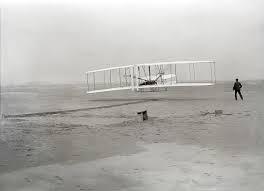The First time Mankind Got Wings- Story of Wright Brothers!
These days flying is a part of our daily lives but it was not always the case. Earlier, flying was just a dream for mankind until it became possible.
In the annals of human history, few achievements have captured the collective imagination as profoundly as the invention of flight. The tale of the Wright Brothers and their relentless pursuit of this audacious dream remains an inspiring testament to innovation, determination, and the boundless human spirit. The story of how Orville and Wilbur Wright ushered in the age of aviation is a testament to their unyielding curiosity, rigorous scientific method, and unwavering determination to conquer the skies.

Born in the late 19th century, Orville and Wilbur Wright grew up in Dayton, Ohio. Their fascination with mechanics and the way things worked began at an early age, fueled by their father’s gift of a small toy helicopter. This seemingly simple gift ignited a spark that would set them on an extraordinary journey.
Formal education only played a limited role in the Wright brothers’ lives. While they attended high school, neither pursued a college degree. Instead, they relied on their inherent curiosity and resourcefulness to gain the knowledge they needed. They voraciously read books, attended lectures, and corresponded with experts in various fields. Their tireless pursuit of knowledge laid the foundation for their groundbreaking work in aviation.
The brothers’ fascination with bicycles translated into practical skills that proved invaluable in their aeronautical endeavors. They operated a bicycle shop, where they honed their engineering skills and developed an innate understanding of mechanics. This hands-on experience with mechanical devices cultivated their ability to design, build, and repair intricate machinery, a skill set that would prove instrumental in their quest for flight.
It was Wilbur who first articulated the challenges of controlled flight. He recognized that achieving true flight required more than just building a machine that could get off the ground—it required mastering the art of stability and control. The brothers immersed themselves in aeronautical literature, studying the works of pioneers like Sir George Cayley and Octave Chanute. They conducted their own experiments and, through meticulous observation, gained insights into the dynamics of flight.
The Wright brothers believed in a methodical approach to experimentation. They began by testing their ideas with kites and gliders. Their early glider designs were informed by the principles of aerodynamics they had learned through extensive reading and correspondence. Their willingness to challenge conventional wisdom and incorporate their own observations led to innovations such as wing warping—a technique that allowed them to control the roll of their gliders.
In December 1903, after years of experimentation, the Wright brothers achieved their ultimate goal: powered flight. They had chosen Kitty Hawk, North Carolina, for its consistent winds and soft sandy terrain, ideal for testing their aircraft. On December 17th, 1903, the Wright Flyer, a biplane with a wingspan of 40 feet, lifted off the ground with Orville at the controls. The flight lasted just 12 seconds, covering a distance of 120 feet. It was a modest achievement by today’s standards, but it was a giant leap for mankind.
The success of the Wright brothers’ first powered flight marked the birth of aviation as we know it today. Their accomplishments didn’t just end with that momentous day in Kitty Hawk. They continued to refine their designs, improving both the aircraft’s performance and the pilot’s control over it. Their dedication to understanding the intricacies of flight laid the groundwork for future innovations in aviation technology.
The story of the Wright Brothers is a tale of human ingenuity and relentless determination. Their journey from bicycle mechanics to aviation pioneers serves as an enduring reminder that great achievements often stem from humble beginnings and a relentless pursuit of knowledge. Their legacy lives on in every modern aircraft that graces the skies, reminding us that the impossible is only a challenge waiting to be conquered. The Wright Brothers’ relentless pursuit of the dream of flight has forever changed the course of history, proving that with the right blend of curiosity, innovation, and hard work, humans can overcome the barriers that once seemed insurmountable.
